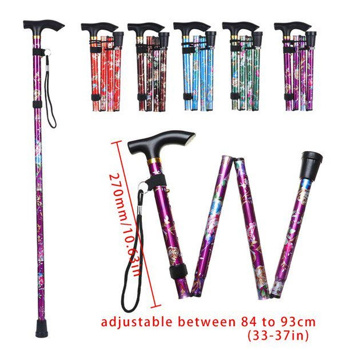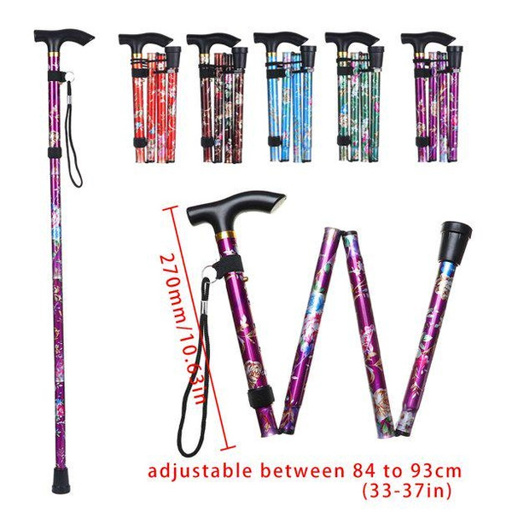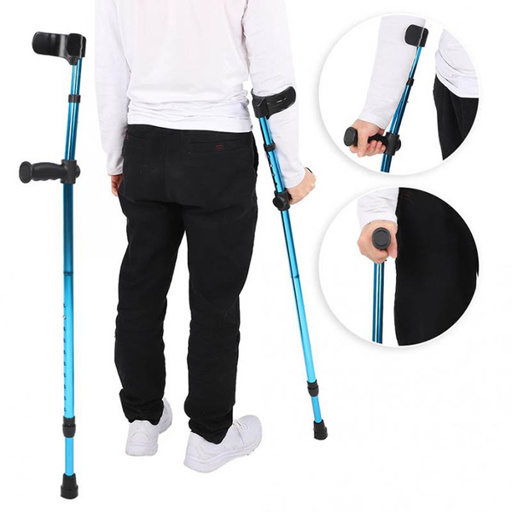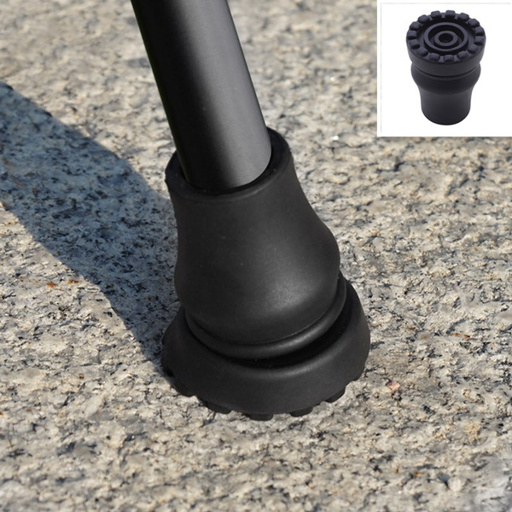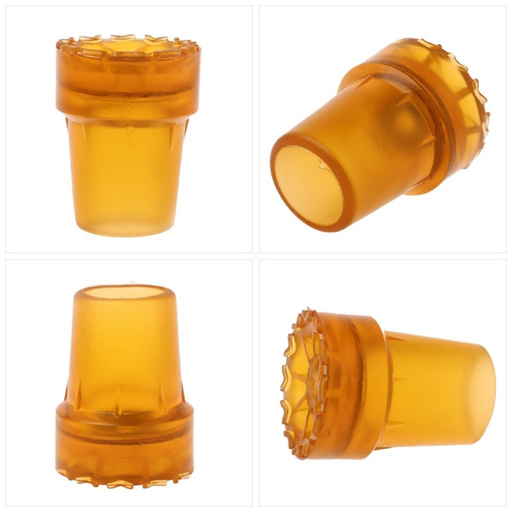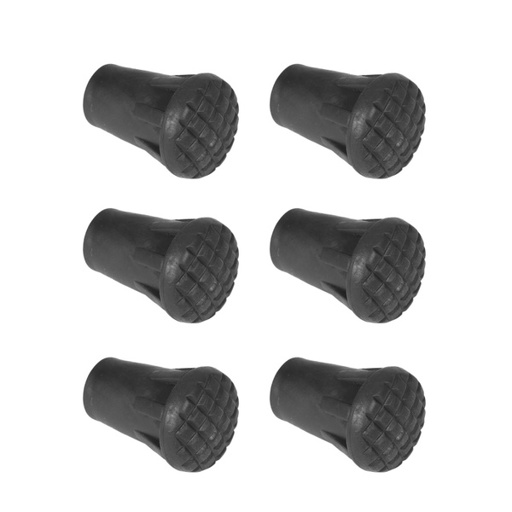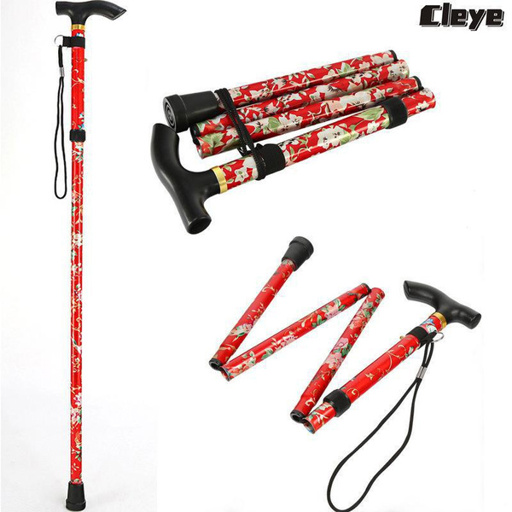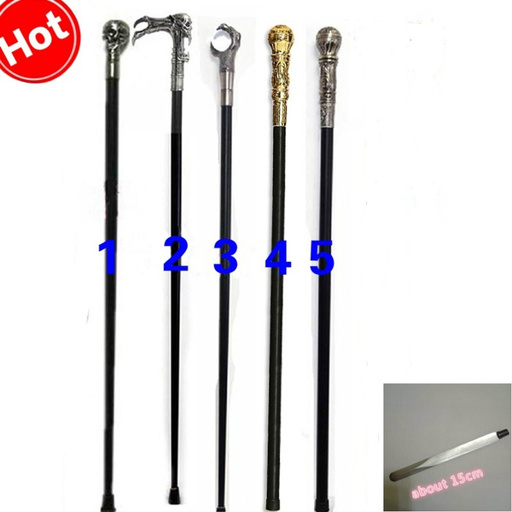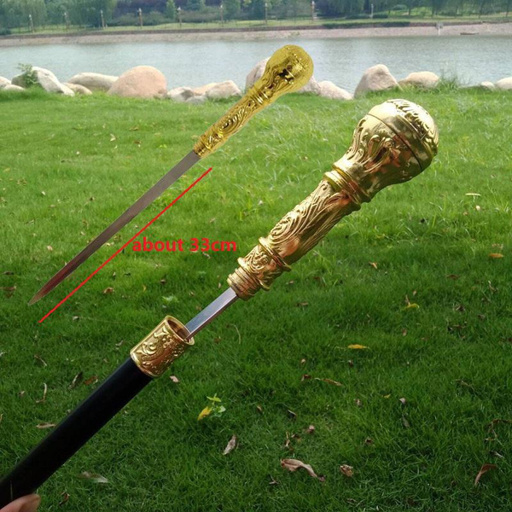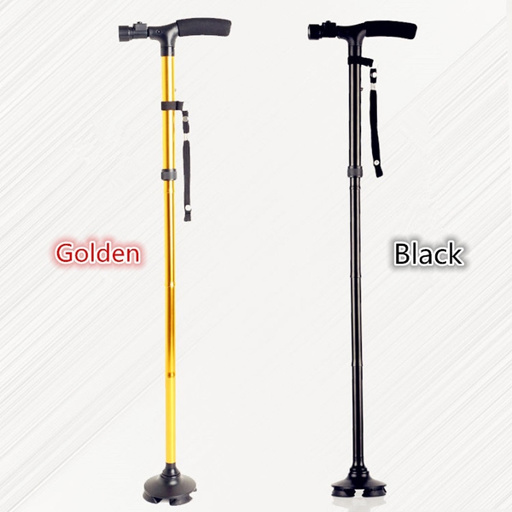Bestsellers for Crutches
Crutches are mobility aids that help individuals move around when recovering from an injury. They are commonly used after an injury to provide support and stability. To ensure proper fit, it is important to adjust the crutches according to your height and arm length. Coverage for crutches by insurance varies, so it is advisable to check with your insurance provider. Crutches are different from walkers as they provide more stability and support. The best type of crutches for long-term use depends on individual needs and preferences. Using crutches on stairs is possible, but it requires extra caution and technique. There are different types of crutches available, including underarm crutches, forearm crutches, and platform crutches. Using crutches safely and effectively involves proper positioning, weight distribution, and movements. There are lightweight and portable options available for those who require them.
How Do Crutches Help in Mobility?
Crutches are mobility aids that provide support and stability to individuals with injuries or disabilities affecting their ability to walk. They help distribute weight away from the legs and feet, allowing users to maintain balance and move around more easily. Here are some ways in which crutches assist in mobility:
Weight-bearing support: Crutches help transfer body weight from the lower extremities to the upper body, reducing the load on injured or weakened legs. This can be especially beneficial for individuals recovering from foot, ankle, or leg injuries.
Improved balance: Crutches provide an additional point of contact with the ground, enhancing stability and balance while walking. This is particularly important for those with mobility limitations or conditions that affect their coordination.
Increased independence: By using crutches, individuals can regain some level of independence and mobility, allowing them to perform daily activities and move around with greater ease.
Flexibility and adjustability: Crutches are designed to be adjustable, allowing users to customize their height and fit according to their specific needs. This adaptability ensures optimal comfort and support during use.
Assistance on uneven surfaces: Crutches enable users to navigate various terrains, including stairs, ramps, and uneven surfaces. With proper technique and practice, individuals can safely maneuver through different environments.
Temporary aid during recovery: Crutches are often used as a temporary aid during the healing process after an injury or surgery. They provide support until individuals regain their strength and mobility.
It's important to note that proper training and instruction on how to use crutches are essential for safe and effective mobility. Consulting with a healthcare professional or physical therapist can help ensure that crutches are used correctly and provide the intended benefits.
Why Are Crutches Used After an Injury?
Crutches are commonly used after an injury to provide support and stability while walking. They help to reduce weight-bearing on the injured leg or foot, allowing it to heal properly. Here are some reasons why crutches are used after an injury:
Immobilization: Crutches help to immobilize the injured leg or foot, preventing further damage and promoting healing.
Pain Relief: By reducing weight-bearing on the injured limb, crutches can help to alleviate pain and discomfort.
Assistance with Mobility: Crutches provide a means of support and stability, allowing individuals with injuries to move around more easily and independently.
Prevention of Further Injury: Crutches help to prevent additional strain or injury to the injured leg or foot by reducing the amount of weight placed on it.
Facilitation of Rehabilitation: Crutches can be used as part of a rehabilitation program, helping individuals regain strength, balance, and mobility as they recover from their injury.
It is important to note that the use of crutches should be guided by a healthcare professional who can assess the specific needs of the individual and provide proper instructions on their use.
Crutches: How To Adjust Them for Proper Fit
Properly adjusting crutches is essential for ensuring comfort, stability, and safety while using them. Here are some steps to help you adjust your crutches for a proper fit:
Height Adjustment: Start by standing up straight with your shoes on. The top of the crutches should be about 1-2 inches below your armpits. Adjust the height of the crutches by loosening the adjustment bolts or clips and sliding the inner tube up or down until you reach the desired height. Make sure both crutches are adjusted to the same height.
Handgrip Adjustment: The handgrips of the crutches should be at a comfortable level, allowing your elbows to bend at a slight angle (about 15-30 degrees) when you hold onto them. To adjust the handgrips, loosen the adjustment bolts or clips and slide the handgrips up or down until they are at the desired height. Tighten the bolts or clips securely to ensure they stay in place.
Armrest Pad Adjustment: Some crutches have armrest pads that provide additional support and comfort for your arms. Adjust the armrest pads so that they are at a comfortable height and provide support for your forearms when you lean on them.
Check Stability: Once you have adjusted the crutches to the proper height and handgrip position, make sure they feel stable and secure. Test them by putting weight on them and taking a few steps. If they feel wobbly or unstable, double-check that all adjustment bolts or clips are tightened securely.
Remember, it's important to consult with a healthcare professional or physical therapist for guidance on adjusting your crutches properly. They can provide personalized instructions based on your specific needs and ensure that you are using the crutches correctly.
By following these steps and adjusting your crutches for a proper fit, you can improve your mobility and reduce the risk of discomfort or injury while using them.
Are Crutches Covered by Insurance?
The coverage of crutches by insurance can vary depending on your specific insurance plan. In many cases, crutches are considered durable medical equipment (DME) and may be covered under your health insurance policy. However, it is important to check with your insurance provider to understand the details of your coverage.
When contacting your insurance provider, be sure to ask about any requirements or restrictions for coverage. Some insurance plans may require a prescription from a healthcare professional in order to cover the cost of crutches. Additionally, there may be limitations on the type or duration of coverage for crutches.
It is also worth noting that even if crutches are covered by your insurance, you may still be responsible for a portion of the cost. This could include deductibles, co-pays, or co-insurance amounts. Understanding your insurance coverage and any associated costs will help you make informed decisions about obtaining crutches.
If you are unsure about your insurance coverage or have questions about obtaining crutches, it is recommended to reach out to your insurance provider directly. They will be able to provide you with the most accurate and up-to-date information regarding your specific policy.
How Do Crutches Compare to Walkers?
When it comes to mobility aids, crutches and walkers are two popular options. Both can provide support and assistance to individuals with injuries or mobility issues. However, there are some key differences between the two.
Stability and Support
Crutches offer more stability and support compared to walkers. They require the user to bear weight on their arms and hands, which can provide a greater sense of balance and control. Crutches are often recommended for individuals with injuries or conditions that affect one leg or foot.
On the other hand, walkers provide a wider base of support and are generally more stable than crutches. They have four legs with rubber tips that provide traction and stability when walking. Walkers are suitable for individuals who need more support and assistance in maintaining their balance.
Maneuverability
Crutches allow for more maneuverability compared to walkers. With crutches, users can easily navigate tight spaces, turn corners, and move around obstacles. The lightweight design of crutches makes them more agile and easier to maneuver in crowded areas or narrow hallways.
Walkers, on the other hand, have a wider frame that can make maneuvering in tight spaces more challenging. They may require more effort to turn corners or navigate through narrow doorways.
Weight-Bearing Capacity
Crutches are designed to bear weight on the arms and hands of the user. They can support a significant amount of body weight, making them suitable for individuals with injuries or conditions that require non-weight bearing or partial weight-bearing.
Walkers are designed to support the user's body weight directly through the legs and feet. They have a higher weight-bearing capacity compared to crutches, making them suitable for individuals who can bear some or all of their body weight.
Versatility
Crutches are versatile in terms of adjustability and adaptability. They can be adjusted to accommodate users of different heights and arm lengths. Crutches also come in various types, such as underarm crutches and forearm crutches, to cater to different needs and preferences.
Walkers are also adjustable to some extent, with options for height adjustment. However, they may not offer the same level of customization as crutches.
Conclusion
In summary, crutches provide more stability and maneuverability, making them suitable for individuals with injuries or conditions affecting one leg or foot. Walkers offer a wider base of support and higher weight-bearing capacity, making them suitable for individuals who need more stability and assistance in maintaining balance. The choice between crutches and walkers depends on the specific needs and circumstances of the individual. It is recommended to consult with a healthcare professional to determine the most appropriate mobility aid for your situation.
Which Type of Crutches Is Best for Long-Term Use?
When it comes to choosing crutches for long-term use, there are a few factors to consider. The right type of crutches can provide comfort, stability, and ease of use for extended periods. Here are some options to consider:
Standard Underarm Crutches: These are the most common type of crutches and are suitable for individuals with good upper body strength. They feature padded underarm supports and handgrips for added comfort. Standard underarm crutches are adjustable in height and can accommodate a wide range of users.
Forearm Crutches: Also known as "Lofstrand" or "Canadian" crutches, forearm crutches provide additional support and stability compared to standard underarm crutches. They have a cuff that wraps around the forearm, allowing the user to bear weight on their arms rather than their underarms. Forearm crutches are often recommended for individuals with long-term mobility needs.
Platform Crutches: Platform crutches, also known as "elbow crutches," feature a platform or trough instead of handgrips. This design allows users to rest their forearms on the platform, distributing weight more evenly and reducing strain on the hands and wrists. Platform crutches can be a good option for individuals with limited hand or wrist strength.
Hands-Free Crutches: Hands-free crutches, such as knee scooters or knee walkers, provide an alternative to traditional crutches. These devices allow users to rest their injured leg on a padded platform while propelling themselves forward with their other leg. Hands-free crutches can be beneficial for individuals with lower leg injuries or those who have difficulty using traditional crutches.
When choosing the best type of crutches for long-term use, it's important to consider your specific needs, comfort level, and mobility requirements. Consulting with a healthcare professional or physical therapist can also provide valuable guidance in selecting the most suitable crutches for your situation.
Can Crutches Be Used on Stairs?
Using crutches on stairs can be challenging, but with the right technique and caution, it is possible to navigate stairs safely. Here are some tips for using crutches on stairs:
Take it slow: Approach the stairs with caution and take your time. It's important to maintain a steady pace and avoid rushing.
Use handrails: If available, always use handrails for support and stability. Hold onto the handrail with one hand while using the crutches with the other.
Determine your technique: There are two common techniques for using crutches on stairs:
The "up with the good, down with the bad" technique: When going up the stairs, lead with your unaffected leg and bring your crutches up to the next step. Then, bring your affected leg up to the same step. When going down the stairs, start by placing your crutches on the lower step, followed by your affected leg, and then bring your unaffected leg down to the same step.
The "three-point" technique: This technique involves keeping one crutch under each arm and using the handrail for support. Step up or down with your unaffected leg first, followed by both crutches, and then bring your affected leg up or down to the same step.
Practice proper balance: Maintain a stable and balanced posture while using crutches on stairs. Keep your weight centered over your crutches and avoid leaning too far forward or backward.
Seek assistance if needed: If you feel unsure or unsafe using crutches on stairs, don't hesitate to ask for help. It's better to have someone assist you than risk a fall or injury.
Remember, using crutches on stairs requires practice and coordination. If you're unsure about your ability to navigate stairs safely, consult with a healthcare professional for guidance and support.
Crutches: What Are the Different Types Available?
Crutches are mobility aids that provide support and assistance to individuals with injuries or limited mobility. There are several different types of crutches available, each designed to meet specific needs and preferences. Here are some of the most common types of crutches:
Underarm Crutches: Underarm crutches, also known as axillary crutches, are the most traditional and widely used type of crutches. They consist of a padded underarm support and handgrips. Underarm crutches are adjustable in height and provide stability and support while walking.
Forearm Crutches: Forearm crutches, also known as Lofstrand or Canadian crutches, have a cuff that wraps around the forearm, providing support and stability. These crutches allow for greater mobility and independence compared to underarm crutches. They are often used by individuals with long-term mobility limitations.
Platform Crutches: Platform crutches, also known as triceps crutches, have a platform instead of handgrips, allowing individuals to rest their forearms on the platform for support. These crutches are suitable for individuals with weak grip strength or limited hand function.
Leg Support Crutches: Leg support crutches, also known as knee scooters or knee walkers, are an alternative to traditional crutches for individuals with lower leg injuries or surgeries. These devices have a padded platform to support the injured leg and wheels for mobility.
Hands-Free Crutches: Hands-free crutches, such as iWalk or KneeRover, are innovative alternatives to traditional crutches that allow individuals to walk without using their hands. These devices provide support through a platform or knee rest and are ideal for individuals with lower leg injuries or surgeries.
When choosing the right type of crutch, it's important to consider factors such as the nature of the injury, the individual's mobility limitations, and personal preferences. Consulting with a healthcare professional or physical therapist can help determine the most suitable type of crutch for an individual's specific needs.
By understanding the different types of crutches available, individuals can make an informed decision and select the crutch that best supports their mobility and recovery.
How To Use Crutches Safely and Effectively
Using crutches properly is essential for maintaining stability and mobility while recovering from an injury or surgery. Here are some guidelines to help you use crutches safely and effectively:
Proper Fit: Ensure that your crutches are adjusted to the correct height. The handgrips should be at wrist level, and there should be a slight bend in your elbow when you hold onto the handgrips. Adjust the height of the crutches by loosening or tightening the adjustment bolts.
Weight Distribution: When using crutches, it's important to distribute your weight correctly. Place your weight on your hands and arms, not on your armpits. Avoid putting too much pressure on your underarms, as this can cause discomfort and nerve damage. Instead, use your hands and arms to support your weight.
Walking Technique: To walk with crutches, start by standing with your crutches slightly in front of you. Move the crutches forward, followed by your injured or weaker leg. Finally, bring your stronger leg forward. Repeat this sequence as you move forward. Take small steps and maintain a steady pace.
Stairs: When using crutches on stairs, it's important to exercise caution. If possible, use a railing for support. When going up stairs, lead with your stronger leg first, followed by the crutches and then your weaker leg. When going down stairs, place your crutches and weaker leg first, followed by your stronger leg.
Obstacles: Be mindful of obstacles in your path while using crutches. Take extra care when navigating uneven surfaces, curbs, or slippery areas. Use handrails or ask for assistance if needed.
Resting: Take regular breaks to rest and relieve any discomfort or fatigue. Find a stable surface to sit on or lean against for support.
Physical Therapy: If recommended by your healthcare provider, consider attending physical therapy sessions to learn proper crutch techniques and exercises to improve strength and mobility.
Remember to consult with your healthcare provider or physical therapist for personalized guidance on using crutches safely and effectively. Following these guidelines will help ensure a smoother recovery process and minimize the risk of further injury.
Which Crutches Are Lightweight and Portable?
When it comes to choosing crutches that are lightweight and portable, there are several options available. These crutches are designed to be easy to carry and maneuver, making them ideal for individuals who need mobility assistance on the go. Here are some types of lightweight and portable crutches to consider:
Folding Crutches: Folding crutches are designed to fold up for easy storage and transportation. They typically have a push-button mechanism that allows them to be folded and unfolded quickly. These crutches are lightweight and can easily fit into a bag or backpack when not in use.
Adjustable Telescopic Crutches: Telescopic crutches have adjustable height settings, allowing users to customize the crutch length to their specific needs. These crutches are often made from lightweight materials such as aluminum or carbon fiber, making them easy to carry and handle.
Forearm Crutches: Forearm crutches, also known as elbow crutches, are designed to provide support under the forearm rather than the armpit. These crutches typically have a cuff that fits around the forearm and a handle for gripping. Forearm crutches are often lighter and more compact than traditional underarm crutches.
Underarm Crutches with Ergonomic Design: Some underarm crutches are specifically designed with ergonomic features to reduce strain on the user's hands, wrists, and shoulders. These crutches may have padded handles, adjustable cuffs, or shock-absorbing features for added comfort.
When choosing lightweight and portable crutches, it's important to consider factors such as weight capacity, adjustability, durability, and user comfort. It's also recommended to consult with a healthcare professional or physical therapist to ensure that the chosen crutches meet your specific needs and requirements.
By opting for lightweight and portable crutches, individuals can maintain their mobility while minimizing the burden of carrying and transporting their assistive devices.
Wish Buying Guide
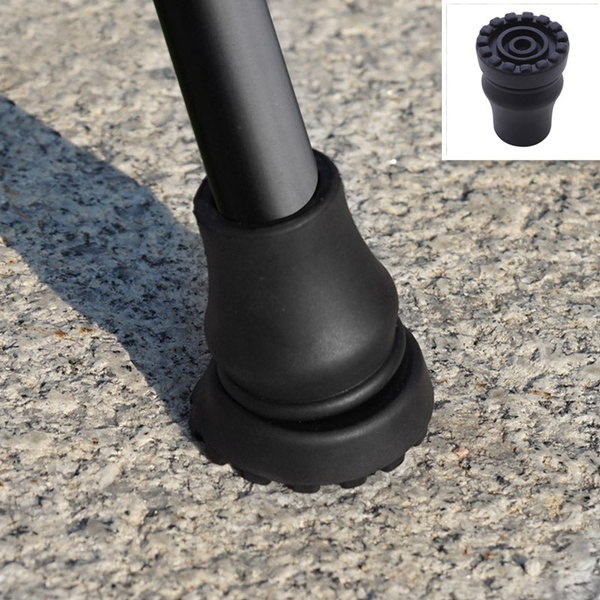
Elderly Care Gift for Adults: Adjustable Telescopic Walking Cane
This Elderly Care Gift for Adults is an adjustable telescopic walking cane that can be used both indoors and outdoors. It has a non-slip rubber tip for extra security, safety, and support as well as a non-skid foot to keep the user safe in wet weather. It conveniently folds into a small shape when not in use for easy storage and transportation, with a polythene wallet included. The walking cane is available in five colors (Black/Red/Green/Purple/Blue), made of aluminum alloy, and comes with one adjustable walking stick.
- Adjustable height feature provides a custom fit for each user, enhancing their comfort and stability.
- The telescopic design is appreciated for its compactness, making the cane easy to store and carry around.
- Users love the high quality of materials used, contributing to the cane's durability and sturdiness.
- Many reviews mention the comfortable handle grip, which prevents hand fatigue during prolonged use.
- The cane's stylish design is frequently praised, making it a popular choice among users who value aesthetics alongside functionality.
- Users appreciate the added safety features, such as a non-slip tip, providing extra security on different terrains.
- The product is often referred to as an ideal gift for elderly adults, due to its practicality and thoughtful design.
Folding Walking Stick Underarm Cane for Seniors Disabled
This Folding Walking Stick Underarm Cane is perfect for seniors and the disabled. It is made of Aluminum Alloy and ABS, is adjustable at 4 levels on the upper half and 10 levels on the lower half, and comes in a vibrant blue color. It is easy to use, strong enough to support those with limited mobility, and suitable for people of all ages.
- Lightweight and Portable: Many users appreciate the easy-to-carry design of the walking stick, which makes it ideal for travel.
- Folding Feature: The ability to fold up the cane when not in use is a major plus point for many buyers. This feature adds to its portability and storage convenience.
- Sturdy Construction: Users report that despite its lightweight design, the walking stick is very sturdy and provides reliable support.
- Comfortable Grip: The underarm cane is designed with a comfortable grip, which users find very beneficial, especially for prolonged use.
- Adjustable Height: The adjustable height feature is highly praised by users of different heights. It enhances usability and comfort.
- Ideal for Seniors and Disabled: This product is specifically designed to cater to seniors and disabled individuals' needs, making it an excellent aid for mobility.
- Excellent Value for Money: Many buyers feel that given its features and benefits, the walking stick offers great value for their money.
Rubber Walking Stick Crutch Cane Bottom Pads Cane Cap Cover
This Rubber Walking Stick Crutch Cane Bottom Pads Cane Cap Cover has many great features. It is made of aluminum alloy and PVC, giving it a sturdy and durable build. The product comes in three sizes, with the length being 4.9cm and the bottom diameter being 3.5cm. The measurements are precise with an error of only 1cm, ensuring accuracy and quality of the product. The product also comes with a color option of black for those who want to have an aesthetically pleasing cane cap cover.
- Provides excellent traction and stability during walks
- Constructed from durable rubber ensuring longevity
- Easy to attach to most standard size canes
- Customers appreciate the non-slip feature that offers improved safety
- Increases the lifespan of walking sticks or crutches
- Effectively reduces noise caused by the cane or crutch hitting the ground
- Offers a comfortable grip, preventing hand fatigue during extended use.


